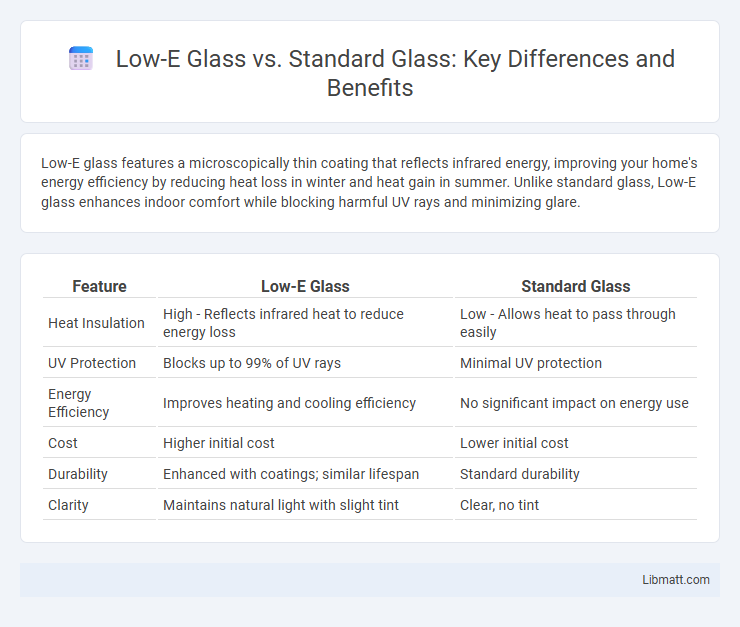Low-E glass features a microscopically thin coating that reflects infrared energy, improving your home's energy efficiency by reducing heat loss in winter and heat gain in summer. Unlike standard glass, Low-E glass enhances indoor comfort while blocking harmful UV rays and minimizing glare.
Table of Comparison
| Feature | Low-E Glass | Standard Glass |
|---|---|---|
| Heat Insulation | High - Reflects infrared heat to reduce energy loss | Low - Allows heat to pass through easily |
| UV Protection | Blocks up to 99% of UV rays | Minimal UV protection |
| Energy Efficiency | Improves heating and cooling efficiency | No significant impact on energy use |
| Cost | Higher initial cost | Lower initial cost |
| Durability | Enhanced with coatings; similar lifespan | Standard durability |
| Clarity | Maintains natural light with slight tint | Clear, no tint |
Introduction to Low-E Glass and Standard Glass
Low-E glass features a microscopically thin metallic coating that reflects infrared energy while allowing visible light to pass through, enhancing energy efficiency and comfort in buildings. Standard glass, typically made from clear soda-lime silica, lacks this coating and allows more heat transfer, leading to higher energy consumption. Choosing Low-E glass for Your windows significantly reduces heat loss in winter and heat gain in summer compared to standard glass.
Understanding the Science Behind Low-E Glass
Low-E glass features a microscopically thin, transparent coating that reflects infrared energy (heat) while allowing visible light to pass through, significantly improving energy efficiency compared to standard glass. This coating reduces heat transfer by reflecting interior heat back inside during winter and blocking external heat in summer, lowering heating and cooling costs. The selective coating technology balances solar gain and insulation, making Low-E glass an advanced solution for thermal performance in modern energy-efficient buildings.
Key Differences Between Low-E Glass and Standard Glass
Low-E glass features a microscopically thin coating that reflects infrared energy while allowing visible light to pass through, enhancing thermal insulation compared to standard glass. Standard glass lacks this coating, resulting in higher heat transfer and lower energy efficiency. The reflective properties of Low-E glass reduce UV damage and glare, whereas standard glass offers minimal protection against these elements.
Energy Efficiency: Low-E vs Standard Glass
Low-E glass significantly improves energy efficiency by reducing heat transfer through its microscopically thin, transparent coatings that reflect infrared energy, keeping interiors warmer in winter and cooler in summer compared to standard glass. Standard glass lacks this specialized coating, resulting in higher heat loss in cold seasons and increased heat gain during warmer months, leading to elevated energy consumption for heating and cooling. The energy-saving capability of Low-E glass directly translates to lower utility bills and enhanced environmental performance in residential and commercial buildings.
Impact on Indoor Comfort and Temperature Control
Low-E glass significantly improves indoor comfort by reflecting infrared heat while allowing visible light to pass through, reducing heat gain in summer and heat loss in winter. This advanced coating helps maintain a consistent indoor temperature, minimizing cold spots near windows and reducing reliance on heating and cooling systems. Standard glass lacks these insulating properties, often leading to greater temperature fluctuations and less energy efficiency.
Cost Comparison: Initial Investment and Long-Term Savings
Low-E glass typically has a higher initial investment cost compared to standard glass due to advanced coatings that enhance energy efficiency. Despite this upfront expense, Low-E glass offers significant long-term savings by reducing heating and cooling costs through improved insulation and solar heat control. Over time, the energy cost reductions and potential increases in property value generally offset the initial price difference.
UV Protection and Fading Resistance
Low-E glass offers superior UV protection by blocking up to 99% of harmful ultraviolet rays, significantly reducing the risk of interior fading compared to standard glass. This advanced coating minimizes the penetration of UV radiation, preserving furniture, flooring, and artwork from discoloration and degradation over time. Standard glass lacks this specialized barrier, resulting in higher UV transmission and accelerated fading of interior materials.
Environmental Benefits of Low-E Glass
Low-E glass significantly reduces energy consumption by minimizing heat transfer through windows, which leads to lower heating and cooling demands in buildings. Its reflective coating blocks ultraviolet and infrared light while allowing visible light to pass, thereby reducing greenhouse gas emissions associated with energy production. Compared to standard glass, Low-E glass enhances thermal insulation, contributing to improved indoor comfort and decreased reliance on fossil fuels for temperature regulation.
Choosing the Right Glass for Your Home or Business
Low-E glass offers superior energy efficiency by reflecting infrared heat while allowing visible light to pass through, reducing heating and cooling costs in both homes and businesses. Standard glass lacks this thermal control, resulting in higher energy consumption and less comfort due to heat gain or loss. Selecting Low-E glass enhances insulation, UV protection, and overall energy savings, making it the optimal choice for long-term cost-effectiveness and sustainability.
Conclusion: Which Glass Option is Best for You?
Low-E glass offers superior energy efficiency by reflecting infrared heat while allowing visible light, significantly reducing heating and cooling costs compared to standard glass. Standard glass provides basic transparency but lacks insulation properties, leading to higher energy consumption in varying climates. Selecting Low-E glass is ideal for homeowners prioritizing energy savings and comfort, whereas standard glass may suffice for budget-conscious projects with minimal energy-efficiency needs.
Low-E glass vs standard glass Infographic

 libmatt.com
libmatt.com